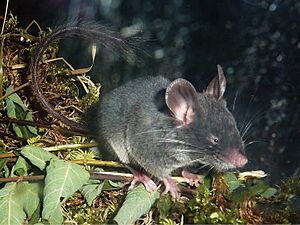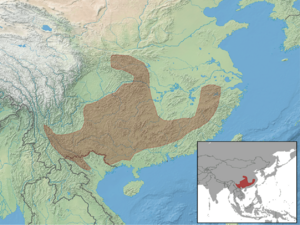Chinese pygmy dormouse facts for kids
Quick facts for kids Chinese pygmy dormouseTemporal range: Late Miocene - recent
|
|
|---|---|
 |
|
| Conservation status | |
| Scientific classification | |
| Genus: |
Typhlomys
|
| Species: |
cinereus
|
| Subspecies | |
|
T. c. cinereus |
|
 |
|
The Chinese pygmy dormouse (scientific name: Typhlomys cinereus) is a tiny rodent found in parts of China and Vietnam. It belongs to a special family of rodents called Platacanthomyidae.
Contents
What Does It Look Like?
The Chinese pygmy dormouse is quite small. Its body, from head to tail base, is about 6.7 to 9 centimeters (2.6 to 3.5 inches) long. Its tail is even longer, about one and a half times its body length!
It has large ears that don't have much fur, and its whiskers are white. The fur on its back is a dark grayish-brown color. Its belly is gray with hairs that have white tips.
The tail is interesting! Near its base, it has rings of scales. But the last two-thirds of the tail are bushy, ending in a fluffy white tip.
Where Does It Live?
This little dormouse lives in Vietnam and many provinces in China. These Chinese provinces include Anhui, Fujian, Guangxi, Guizhou, Hubei, Hunan, Jiangxi, Shaanxi, Sichuan, Yunnan, and Zhejiang.
How Does It Behave?
The Chinese pygmy dormouse makes its home in mountain forests, including areas with lots of bamboo. It's a great climber and spends time in trees. Even though its scientific name Typhlomys might make you think it's blind, it actually isn't!
This dormouse eats different parts of plants. Its diet includes leaves, stems, fruits, and seeds.
Reproduction and Life Cycle
Scientists don't know a lot about how these dormice have babies. However, female dormice have four nipples. Researchers have found pregnant females carrying two to four baby dormice inside them.
The Chinese pygmy dormouse is active at night. It might use echolocation, like bats, to find its way around in the dark.
What Is Its Status?
The Chinese pygmy dormouse is shy and not often seen. This means there might be more of them than we realize. They live in healthy, untouched forests and also on the edges of forests that have been slightly changed. However, they don't seem to live in forests that have grown back after being cut down.
Many national parks and protected areas are located where these dormice live. There are no major threats that worry scientists right now. Because of this, the International Union for Conservation of Nature says the Chinese pygmy dormouse is of "least concern". This means it's not currently in danger of disappearing.


